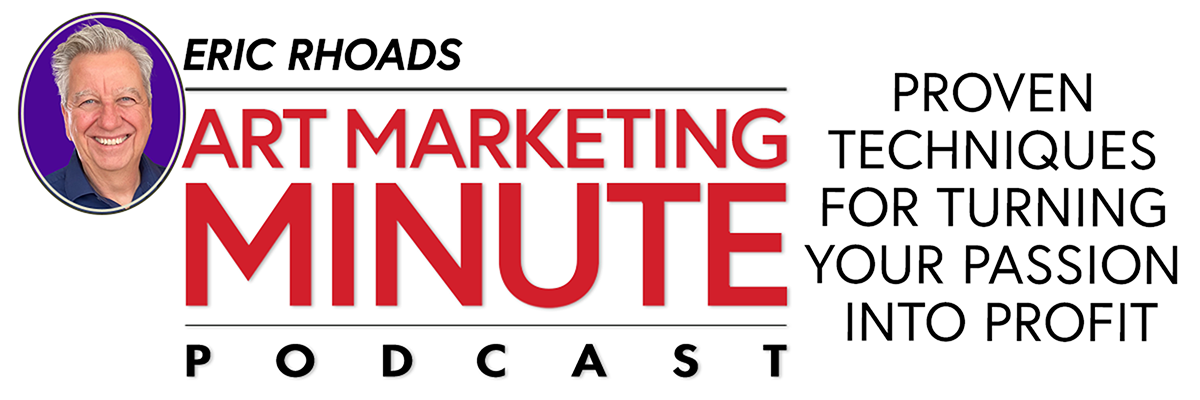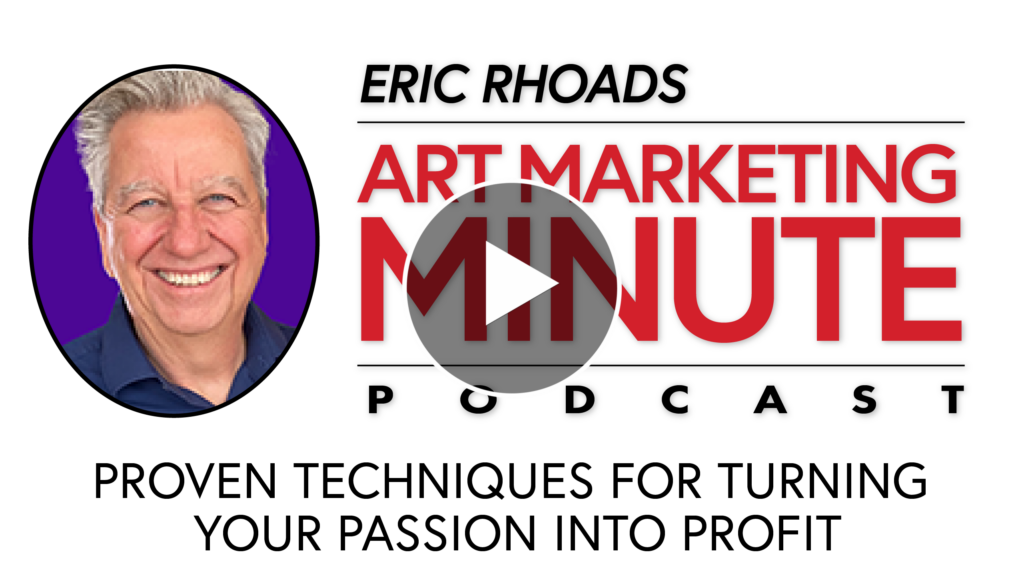In the Art Marketing Minute Podcast, you’ll learn how to sell your art, how to market your paintings, and everything else you need to know in order to have a successful art career. Each episode answers questions from artists by host Eric Rhoads.
In this Art Marketing Minute, Eric Rhoads shares if it’s best to stick to one style or to mix it up, and how to handle inventory and overstock issues.
Listen to the Art Marketing Minute Podcast: Episode 59 >
Submit Your Art Marketing Question:
What questions do you have about selling your art? Email Eric today at [email protected] (include your name and where you’re from) to hear your question answered on an upcoming Art Marketing Minute Podcast.
FULL TRANSCRIPT of the Art Marketing Minute:
DISCLAIMER: The following is the output of a transcription from an audio recording of the Art Marketing Minute. Although the transcription is mostly correct, in some cases it is slightly inaccurate due to the recording and/or software transcription.
Announcer:
This is the Art Marketing Minute with Eric Rhoads, author of the Amazon best selling book, “Make More Money Selling Your Art.” In the marketing minute we answer your questions to help your art career brought to you by artmarketing.com, the place to go to learn more about marketing. Now, here’s your host, arts magazine publisher, Eric Rhoads.
Eric Rhoads:
In the marketing minute I answer your art marketing questions or at least I try and sometimes I never see them before I answer them. I don’t script them. So here we go. email your questions to me [email protected]. Here’s a question from Kate Emery in Farmington, Connecticut. My wife, our grandmother grew up in Farmington, Connecticut, Historical Society there has an old building and it’s, matter of fact, that’s a family farm. Anyway, Kate says Eric, my question is in regards to art shows I paint in a few different styles and different subjects landscape portrait abstract, do you think it makes more sense to stick to one style and subject or to mix it up? On the one hand, it feels like variety will give me more chances to win. But I do. I do think when it comes across it comes across as less professional somehow. Well, I’ll tell you a story, Kate. I had an artist who who did some advertising with me. And she called and she said, You know, my ads didn’t work. I said, Well, they’re working for some people, because I hear I’m hearing from them too. Let’s find out why. So I said, let’s look at your ad and we looked at her and she was advertising portraiture. And so I went to her website with her on the phone and I said, Okay, let’s look at your website. And on the front of the website was a landscape painting. And I said, Well, if you’re advertising portraiture, they modified portraiture there. She said, Well, I do lots of different kinds of painting. I said, Yes, but your advertising, you want to capture what you’re advertising for it because you’re going to drive more people from that than anything else. So I went and I said, Okay, let’s find the portraiture. And so I just kind of did what anybody else would do. And I kind of poked around, I couldn’t find it. couldn’t find it anywhere. Finally, you know, after 10 steps, I found it and I said, Look, you’ve got to bring it to light. I have had this conversation with many artists over many, many, many years. You want to get branded as something because if you brand you get branded as all things you could come branded as nothing. And, I know a lot of artists who do a lot of styles and they might use a synonym, they might use another name. And, let’s say they do abstract they use a better name for their abstract and they have a separate website for their abstract. There’s nothing wrong with lots of subject matter but you want to kind of get known for something and you want to kind of push something I think that’s the answer in terms of art shows. I don’t know if you’re talking about competitions because you said chances to win. I suppose it gives you more chances to win the reality is in in art competitions like the Plein Air Salon, the more things you enter, the more chance as to when you know gallery owners who are our judges might see one thing they like and another thing they don’t like. So you’ve got up, enter two things, you might have a chance to three things you might have a better chance for things might have a different chance. But you know, it’s it boils down to quality, and people are going to pick the best quality, I have found that most artists are not really good at all things, what are you best at, put your best foot forward? And think about that. And it’s not less professional somehow. But it will confuse the marketplace. if let’s say you want in two categories in your, you know, one was an abstract and one was a landscape and your name came up, and both of them you’re going to confuse the marketplace when they see that. So just keep that in mind. Branding is something that we all need to learn and understand. I talked a lot about it in my book. And it is something that is really worth understanding. Because if you get branded incorrectly, it’s really hard to overcome.
Here’s a question from Thomas in Dallas. Again, I’ve not read this one, it says, I have a card line for my art. And the gift store market seems to have fallen through the number say I shouldn’t make any new cards at this time. And that means I don’t have a catalog to use for marketing. I have some loyal customers who are still buying my designs. But many of the stores I sell to still have product from earlier in the year. My question then is about supply and demand for artists. Well, I’m not sure what the question is exactly, Thomas. But I think let me let me see if I can figure this out. What I think you’re saying is, you know, they have inventory, they’re not going to buy new cards because they have inventory. Well, that may or may not be true. First off, a lot of people have inventory because they had their stores closed during COVID. Right. And so, our assumption is that they’re going to have a lot leftover. But, now that people are getting out, they’re spending a lot of money, they’re buying a lot of things, holidays are coming up, I think, if they’re used to seeing you coming out with a new catalog every year and new new stuff every year, I think you need to do it and you want to put your new work out there. And their chances are, they’re gonna order some new work, you just never know what they’re facing. And you said you need a catalog to use for marketing, well use it for marketing, it may or may not be the best year, you may not want to print as many or you might want to take a take a shot, you’re gonna eventually sell them. And you said you have some loyal customers buying your design, so those people will probably buy them. I think I’d go for it, and and also ask yourself this, is there a specialty product that I could put in there that might sell especially well? Right now, for instance, could you do something that is very related to COVID times, that, that people might find fun? It’s for a gift card like pictures of people in masks or whatever, you never know I mean, look for something that will be relevant relevance tends to sell better than non relevance. I hope that helps you and gives you some direction on some art marketing.
Well, this has been the art marketing minute with me. Eric Rhoads. My goal in life is to eliminate the idea of starving artists to help your dreams actually come true. So if you want to submit questions, simply email [email protected]. And to learn more about marketing ideas, you can visit Artmarketing.com. Thanks for listening.
How to Submit Your Art Marketing Questions: What questions do you have about selling your art? Email Eric today at [email protected] (include your name and where you’re from) to hear your question answered on an upcoming Art Marketing Minute Podcast.



Leave A Comment